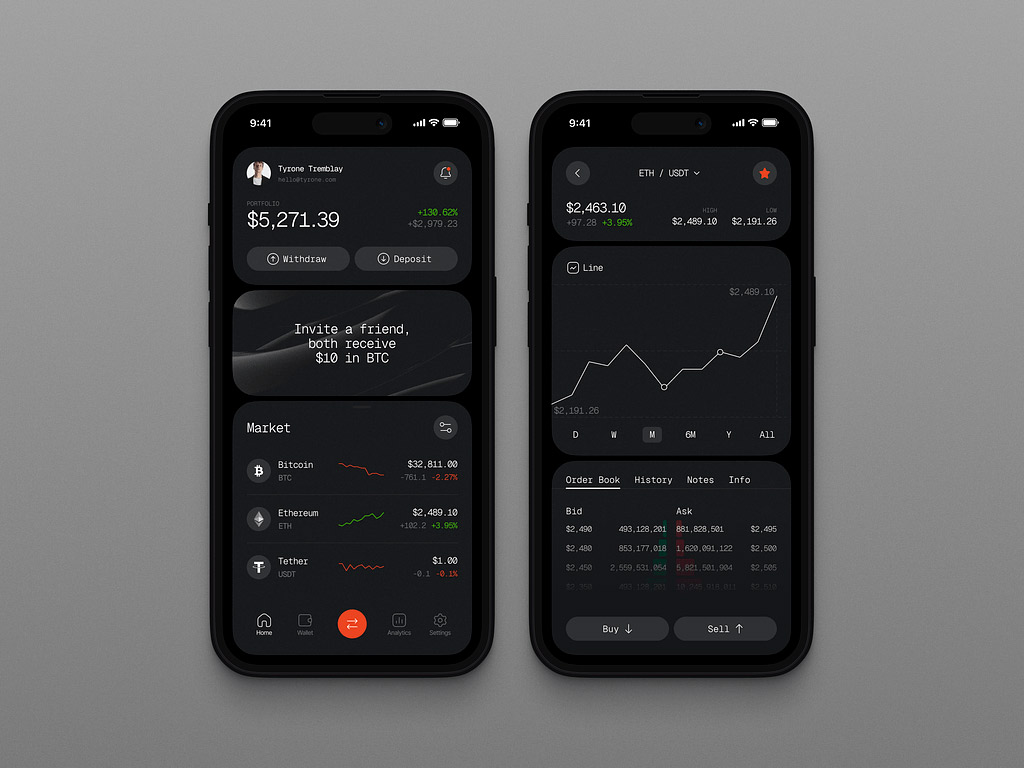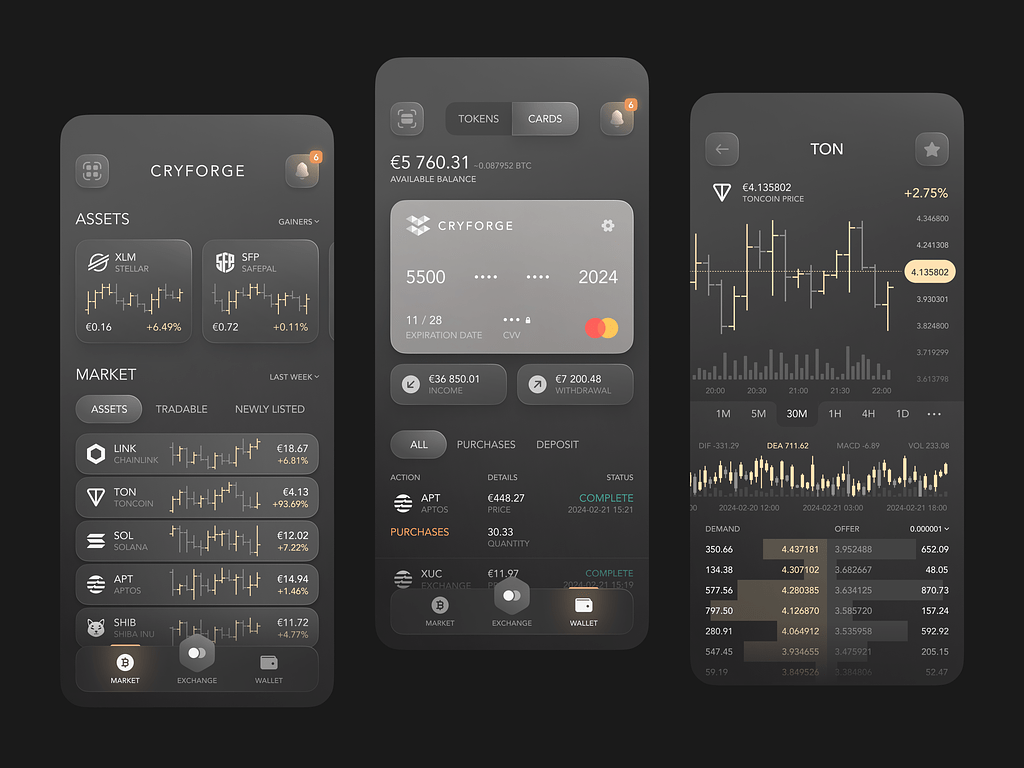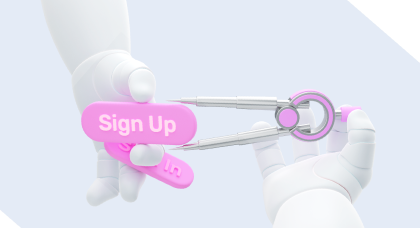Imagine a world where transactions are secure but also transparent and decentralized. Yet, this is not imagination – welcome to the realm of blockchain apps. Traditional systems often leave much to be desired—security breaches, slow transactions, and cumbersome processes that can frustrate users and stifle growth.
Contents:
This technology promises to change all that with a unique solution, cutting through the bureaucratic red tape that often hampers development. Sounds awesome, but where do you start? How do you transform that revolutionary idea in your head into a functioning product?
In this comprehensive guide, we’ll dwell on how to build a blockchain app. We’ll cover the key components you need to consider, from choosing the right platform to understanding smart contracts and implementing responsive interfaces. Whether you’re looking to streamline transactions, enhance security, or foster greater trust among your users, this article will provide valuable insights and practical steps to turn your vision into reality.
Understanding Blockchain Basics
At its core, blockchain is a decentralized digital ledger technology that securely records transactions across multiple computers. This means that once a transaction is added to the blockchain, it is nearly impossible to alter or delete, offering unparalleled transparency and security.
Each block in the chain contains a set of transactions, along with a unique cryptographic hash of the previous block, linking them together in an immutable sequence. This structure eliminates the need for central authorities or intermediaries and builds trust among participants in the network.
The promise of blockchain extends beyond cryptocurrencies like Bitcoin and Ethereum. It has applications across various industries, including supply chain management, healthcare, finance, and more, heralding a new era of operational efficiency and transparency.
Blockchain Market
The global blockchain market has been tremendously growing. It was estimated at $17.57 billion in 2023 and is expected to increase to $825.93 billion by 2032, with a CAGR of 52.8%. Industries are increasingly recognizing the potential of blockchain for enhancing transparency, improving security, and reducing costs. Governments and enterprises worldwide are investing heavily in blockchain research and adoption, paving the way for a myriad of applications from smart contracts to decentralized finance (DeFi) solutions.
What’s more, the increasing attention to digital currencies like Bitcoin and Ethereum jumped to the technology itself.

Potential Competitors in Blockchain Development
Companies like IBM and Microsoft are actively striving to build a blockchain app, offering enterprise-level services that can quickly overshadow smaller startups like you. They provide cloud-based platforms that simplify the adoption, and their extensive resources can be daunting for newcomers.
At the same time, a plethora of startups is emerging, each targeting specific sectors or offering unique functionalities, from supply chain tracking to digital identity solutions. Understanding their value propositions and how they differentiate themselves will help you carve out your niche in this competitive landscape.
As more sectors recognize the transformative potential of blockchain, cross-industry applications are gaining traction. Solutions that offer interoperability, such as platforms designed to engage seamlessly with different sectors, can pose a significant challenge as they appeal to a broader audience.
Potential Challenges
Since we mentioned challenges, let’s dwell on them a bit longer. You need to be prepared to get through different obstacles, should they arise on your blockchain app development journey. Here are some of them:
- Scalability: The number of processed transactions within a given time frame is limited, so it leads to scalability issues. High demand leads to slow processing times and increased transaction fees.
- Interoperability: There are numerous blockchain platforms, each with its protocols and standards. This lack of interoperability between different blockchains hinders communication and data sharing, making it difficult to build a blockchain app that utilize multiple platforms.
- Regulatory Hurdles: The regulatory landscape varies significantly across jurisdictions and is still developing. You may need more clarity regarding compliance with data protection, financial regulations, and anti-money laundering (AML) laws.
- Security Concerns: Vulnerabilities still exist. Hacks and breaches in poorly designed or managed blockchain systems lead to significant financial losses and damage to reputation.
- Complexity and Usability: The technical complexity of blockchain can be a barrier, particularly for non-technical users. Educating stakeholders and clients about how to interact with blockchain applications is essential for widespread adoption.
- Energy Consumption: Certain consensus mechanisms (most notably proof-of-work) require substantial computational power, leading to high energy consumption and raising environmental concerns.
- Market Volatility: Cryptocurrencies can be extremely volatile, affecting investor sentiment and the business models that rely on these assets. This unpredictability can deter investment and long-term planning.
- Integration with Existing Systems: Many organizations are hesitant to adopt blockchain technology due to the challenges associated with integrating it into their operations and infrastructure. Legacy systems may need help to adapt to new blockchain solutions.
- Public Perception and Trust: Despite its potential, blockchain technology often struggles with public perception, largely due to its association with cryptocurrencies and fraud instances.
Identifying Your App Idea
Let’s see how you can put the knowledge into practice. Every idea should have a base, a foundation to stand on. In blockchain app development, it’s your research.
Finding Your Niche
Start with exploring possible niches for your future app. Analyzing current trends, pain points, and user demands will provide insight into areas where your product can add value. Once you figure out the target audience, engage with it through surveys, forums, and social media to gather firsthand information about their challenges. For example, sectors like healthcare, real estate, and supply chains are ripe for innovation, and pinpointing specific bottlenecks can reveal substantial opportunities.
Next, think about how your skills can help the business thrive. Consider your background, abilities, and interests. Diving into a niche that aligns with your expertise will give you a competitive edge. If you have experience in finance, for instance, developing a blockchain app focusing on decentralized finance (DeFi) or payment solutions may be a natural fit. Your deep understanding of industry nuances can inform better product development and enhance marketing strategies.
Once you have potential areas in mind, it’s time to analyze existing competitors. The analysis will reveal gaps in the market and highlight what others are doing well or poorly. Look for niches with some contenders that lack comprehensive solutions. For example, certain verticals within the NFT space are less saturated; finding ways to enhance user experience or address current challenges can differentiate your offering.
Navigating the regulatory landscape is crucial, especially in industries like finance and healthcare. Some niches may present hurdles due to strict regulations, while others could offer more freedom for innovation. Ensure that your chosen niche allows you to comply comfortably with legal requirements while minimizing risks, giving you a smoother path to market.
Validating Your Idea
Before seeking validation, check what your blockchain app does and why it matters. What specific problems does it solve? How does it leverage blockchain technology to create value? A concise value proposition will guide your validation efforts and help you communicate your idea effectively to potential users and stakeholders.
Focus on creating an MVP to introduce a simplified version of your app to the market quickly. This prototype should showcase core functionalities and unique selling points. An MVP enables you to test only the essential features that deliver the main value. This helps minimize development costs while providing tangible data for validation.
Using platforms like Twitter, LinkedIn, or Medium, you can gauge interest in your blockchain app idea by sharing content related to your concept. Run polls or create informative posts to gather initial reactions. Monitor engagement metrics such as shares, likes, and comments to assess interest. Platforms like Kickstarter or Indiegogo can also help you validate the idea. A successful campaign indicates strong market demand, while critical feedback can offer insights for improvement.
Once you’ve gathered data, take the time to analyze the results carefully. Look for patterns that indicate support or hesitation around your concept. If you’ve made significant changes to your concept, consider revalidating it with your audience to ensure alignment with their needs.

Widgets for iWatch OS by Conceptzilla
Planning Your Blockchain App
Now that you have an established concept at hand, it is time to plan the actual implementation and timeframes. Since these are complex things, take the process step by step:
Understand the Blockchain Ecosystem
Familiarize yourself with the different types of blockchains and their respective ecosystems. Decide whether your app will utilize a public blockchain (like Ethereum) or a private one (like Hyperledger). Public blockchains offer transparency and decentralization, while private blockchains provide more control and privacy.
Find info about various consensus models (Proof of Work, Proof of Stake, etc.) and choose one that aligns with your app’s requirements. Each mechanism has its pros and cons regarding scalability, speed, and energy consumption.
Essential Features
Outline the core features your app will offer. Focus on what users need and how blockchain enhances these functionalities. Here are some essential features of a blockchain app:
- Smart Contracts: Support for smart contracts, which are self-executing contracts with the terms directly written into code, allowing for automated, trustless transactions.
- Cryptography: Implement strong cryptographic techniques to secure user data, transactions, and network communication to maintain confidentiality and integrity.
- Transaction Management: Efficient mechanisms for creating, broadcasting, and confirming transactions. This includes transaction history and status tracking.
- Scalability: The ability to handle a growing amount of transactions without compromising the performance of the application.
- Interoperability: Compatibility with other blockchain networks and external systems to facilitate interactions and data sharing across platforms.
- Wallet Integration: Support for cryptocurrency wallets for safe storage and transactions. This could involve integration with existing wallets or the development of a proprietary wallet.
- Auditability and Transparency: The ability to provide a transparent ledger that is auditable by users or third parties, ensuring trust in the system.
- Governance Model: A clearly defined governance model for managing protocol upgrades, changes, and decision-making processes within the network.
- Community Features: Tools to engage users and build a community around the application, including social features, forums, or incentivization mechanisms.
Plan for Security
Security is paramount in blockchain applications. Outline a comprehensive security strategy that covers the following:
- Data Encryption: Use encryption protocols to protect user data and transaction details.
- Regular Audits: Schedule regular audits of your smart contracts and application code to identify vulnerabilities before launch.
- User Education: Provide users with clear instructions on safeguarding their private keys and understanding potential security threats.
Establish a Development Timeline
A realistic timeline will keep your project on track. Break down the blockchain app development process into manageable phases using Agile methodology: research, design, development, testing, deployment, and maintenance. We will discuss them in detail a bit later.
Define Your Budget
Based on the features and concept you’ve picked, allocate resources effectively. Calculate approximate costs for development, marketing, and ongoing maintenance. Don’t forget to factor in costs associated with blockchain transactions (gas fees).
Think how much budget will be spent on blockchain app development services. Identify the necessary skills required for your team, such as blockchain developers, UX/UI designers, and marketing specialists.
In general, the costs vary widely depending on the project’s complexity, team location & skills, tech stack, maintenance, etc. The sum ranges anywhere from $10,000 to over $200,000 based on these factors.

Crypto App Design Concept by Conceptzilla
Choose the Right Technology Stack
The technology stack to build a blockchain app typically includes the following components:
- Blockchain Platform: Choose a platform that aligns with your app’s requirements (Ethereum, Binance Smart Chain, Hyperledger, etc.).
- Smart Contract Development: Use Solidity (for Ethereum) or Chaincode (for Hyperledger). As for the programming language, JavaScript, Go, or Rust is a great option for various platforms.
- Development: Decide on technologies for the front-end (React, Angular) and back-end (Node.js, Python) that work well with your chosen blockchain.
- Database: Pick MongoDB, PostgreSQL, or Cassandra for storing application data. Consider using a distributed database for scalability.
- APIs: Integrate RESTful or GraphQL APIs to connect the front end and blockchain.
- Wallet Integration: Implement wallets like MetaMask for users to interact with your app.
- Deployment: Choose cloud service providers like AWS, Azure, or Google Cloud to deploy your application.
Base the tech stack on your team skills. They should be familiar with the technologies you plan to use.
Development Team
The project requires an experienced blockchain app development company with various skills. Here’s a breakdown of the key roles you may need:
- Blockchain Developer: Responsible for building the blockchain network and creating smart contracts. Needs expertise in blockchain frameworks (e.g., Ethereum, Hyperledger) and languages like Solidity, Go, or Rust.
- Frontend Developer: Focuses on creating the user interface that interacts with the blockchain. Should have proficiency in HTML, CSS, JavaScript, and frameworks like React, Vue.js, or Angular.
- Backend Developer: Manages server-side logic, APIs, and database interactions with experience in Node.js, Python, or Java, along with frameworks suitable for back-end development.
- UI/UX Designer: Responsible for the overall user experience and design of the application.
- DevOps Engineer: Manages deployment, scaling, and maintaining the application infrastructure. Familiar with cloud services (AWS, Azure, Google Cloud) and container technologies (Docker, Kubernetes).
- Quality Assurance (QA) Engineer: Ensures the application is free of bugs and meets quality standards.
- Security Expert: Focuses on the security aspects of the application, especially critical for blockchain technology. Involves auditing smart contracts and securing the infrastructure against vulnerabilities.
- Project Manager: Oversees the project, ensuring timely delivery and alignment with business goals.
- Business Analyst: Identifies business requirements and translates them into technical specifications.
- Compliance Specialist: Ensures that the application complies with relevant regulations and legal frameworks. Particularly important in sectors like finance and healthcare, where compliance is critical.

Crypto Mobile App Concept by Conceptzilla
How to Build a Blockchain App
After careful planning, time to start the actual design and development.
Developing an app is like building a house. You need to create a blueprint first to guide you to the desired result. The process of blockchain app development typically involves several key phases, each aimed at ensuring that the final product is functional, user-friendly, and secure.
Architecture Design
Outline the technical architecture, including how the front end, back end, and blockchain will communicate. Then plan the structure of smart contracts, including functionalities and interactions. Create diagrams to visualize how data will flow within the app and between components. This approach allows you to tweak and re-arrange components before you start the actual design or development.
UI/UX Design
Create low-fidelity wireframes to outline the basic layout of the interface, focusing on usability. Keep things simple, you need it just to test the blockchain app ideas. Once your wireframes look good, build high-fidelity interactive prototypes to simulate the user experience. Include realistic UI elements—buttons, forms, and navigation. To ensure consistency, establish a design system that includes color schemes, typography, iconography, and UI components.
Prototype Testing
Use the prototypes to conduct usability tests with your target audience and gather feedback, then iterate on the design accordingly. Make sure that potential users can solve their major tasks and navigate effortlessly through the app.
Development
Prepare documentation that outlines design specifications for developers. Include assets, design components, and user interactions. Build the user interface based on the finalized designs, ensuring it interacts smoothly with the blockchain. Set up server-side applications, APIs, and databases to handle business logic and data storage. Code the smart contracts required for the app on the chosen blockchain platform and conduct testing.
Testing
Conduct unit tests for both front-end and back-end code, including smart contract testing. Pay attention to interactions between all system components to ensure they work together. Don’t forget about User Acceptance Testing (UAT) and involve real users to validate whether the application meets their needs too.
Deployment
Plan the deployment strategy, including managing database migrations and configuring server environments. Deploy smart contracts to the mainnet, signaling that the application is live for users.
Monitoring and Maintenance
The launch is just the beginning, you need to support the blockchain app afterward. So set up monitoring tools to track performance and usage. Also, continuously address any bugs and provide regular updates based on user feedback. If possible, engage with the user community for suggestions for future features.
Conclusion
Developing a blockchain app is a multifaceted endeavor that requires diligent planning, user-centered design, and meticulous implementation. By following these essential tips and embracing a systematic approach, you can develop a blockchain app that not only fulfills market demands but also stands out in an increasingly crowded space. As you embark on this exciting journey, keep innovation, user experience, and adaptability at the forefront of your efforts, and you’ll be well on your way to creating a successful blockchain solution.
Are you looking for a team to build a blockchain app? Contact us and let’s work together on your next project.

